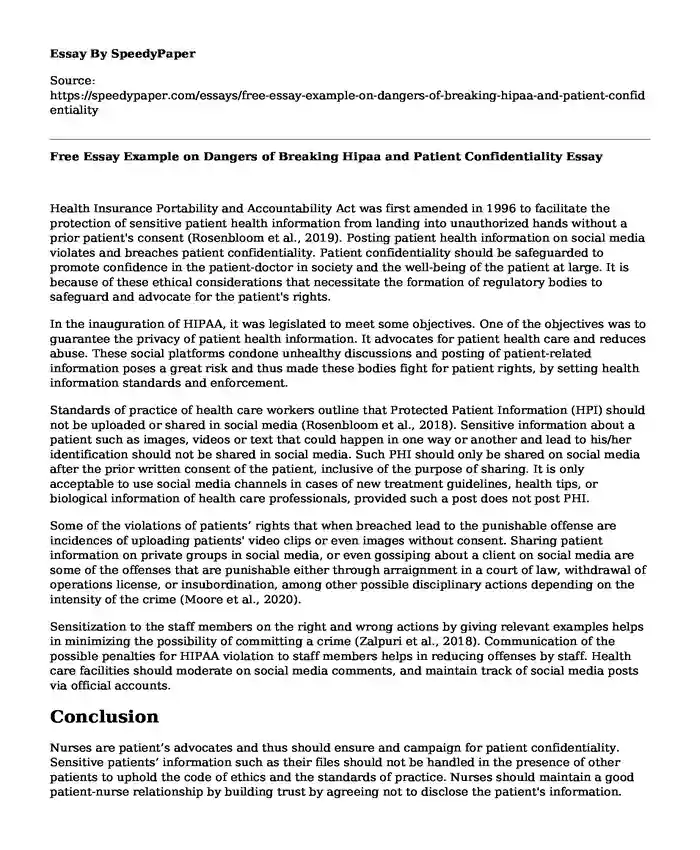
| Type of paper: | Essay |
| Categories: | Health and Social Care Nursing Social media |
| Pages: | 3 |
| Wordcount: | 650 words |
Health Insurance Portability and Accountability Act was first amended in 1996 to facilitate the protection of sensitive patient health information from landing into unauthorized hands without a prior patient's consent (Rosenbloom et al., 2019). Posting patient health information on social media violates and breaches patient confidentiality. Patient confidentiality should be safeguarded to promote confidence in the patient-doctor in society and the well-being of the patient at large. It is because of these ethical considerations that necessitate the formation of regulatory bodies to safeguard and advocate for the patient's rights.
In the inauguration of HIPAA, it was legislated to meet some objectives. One of the objectives was to guarantee the privacy of patient health information. It advocates for patient health care and reduces abuse. These social platforms condone unhealthy discussions and posting of patient-related information poses a great risk and thus made these bodies fight for patient rights, by setting health information standards and enforcement.
Standards of practice of health care workers outline that Protected Patient Information (HPI) should not be uploaded or shared in social media (Rosenbloom et al., 2018). Sensitive information about a patient such as images, videos or text that could happen in one way or another and lead to his/her identification should not be shared in social media. Such PHI should only be shared on social media after the prior written consent of the patient, inclusive of the purpose of sharing. It is only acceptable to use social media channels in cases of new treatment guidelines, health tips, or biological information of health care professionals, provided such a post does not post PHI.
Some of the violations of patients’ rights that when breached lead to the punishable offense are incidences of uploading patients' video clips or even images without consent. Sharing patient information on private groups in social media, or even gossiping about a client on social media are some of the offenses that are punishable either through arraignment in a court of law, withdrawal of operations license, or insubordination, among other possible disciplinary actions depending on the intensity of the crime (Moore et al., 2020).
Sensitization to the staff members on the right and wrong actions by giving relevant examples helps in minimizing the possibility of committing a crime (Zalpuri et al., 2018). Communication of the possible penalties for HIPAA violation to staff members helps in reducing offenses by staff. Health care facilities should moderate on social media comments, and maintain track of social media posts via official accounts.
Conclusion
Nurses are patient’s advocates and thus should ensure and campaign for patient confidentiality. Sensitive patients’ information such as their files should not be handled in the presence of other patients to uphold the code of ethics and the standards of practice. Nurses should maintain a good patient-nurse relationship by building trust by agreeing not to disclose the patient's information. Taking of pictures with the client or even images of clients which could lead to their recognition is always a risk and therefore, a breach of the patient's confidentiality or the HIPAA. As a standard of practice, patient confidentiality and HIPAA should be safeguarded as outlined in the code of ethics, for the dangers of breaching are fatal. Educating nurses, about these dangers will minimize violations of HIPAA and patient confidentiality, which, in a way, will positively impact the quality of care the client will receive.
References
Moore, W., & Frye, S. (2020). Review of HIPAA, part 2: limitations, rights, violations, and role for the imaging technologist. Journal of Nuclear Medicine Technology, 48(1), 17-23. http://tech.snmjournals.org/content/48/1/17.short.
Rosenbloom, S. T., Smith, J. R., Bowen, R., Burns, J., Riplinger, L., & Payne, T. H. (2019). Updating HIPAA for the electronic medical record era. Journal of the American Medical Informatics Association, 26(10), 1115-1119. https://academic.oup.com/jamia/article-abstract/26/10/1115/5544256.
Zalpuri, I., Liu, H. Y., Stubbe, D., Wrzosek, M., Sadhu, J., & Hilty, D. (2018). Social media and networking competencies for psychiatric education: skills, teaching methods, and implications. Academic Psychiatry, 42(6), 808-817. https://link.springer.com/article/10.1007/s40596-018-0983-6.
Cite this page
Free Essay Example on Dangers of Breaking Hipaa and Patient Confidentiality. (2023, Dec 10). Retrieved from https://speedypaper.com/essays/free-essay-example-on-dangers-of-breaking-hipaa-and-patient-confidentiality
Request Removal
If you are the original author of this essay and no longer wish to have it published on the SpeedyPaper website, please click below to request its removal:
- Free Essay on Birth Control for Teenagers: Pros and Cons
- The Blindside Book vs. Movie - Comparison Essay Example
- Management Essay Example: Succession Planning in Nursing
- Free Essay Sample on Assisted Reproductive Technology
- Cholera in Haiti, Essay Sample for Everyone
- Free Essay: Chinese Herbal Medication Interaction with Prescribed Drugs: A Case of Ephedra
- Essay Example: The Difference Between Embryonic Stem Cells and Umbilical Stem Cells
Popular categories




